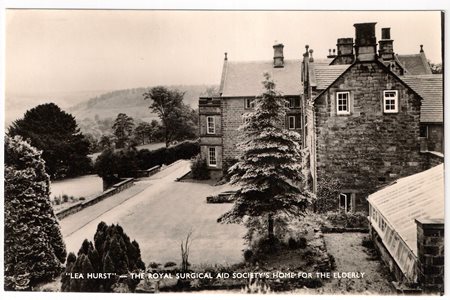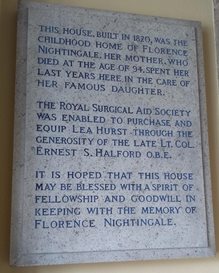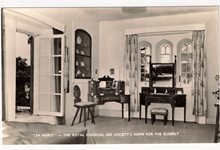History of Lea Hurst - Nightingale's Derbyshire Home
Lea Hurst has been in private hands since Nightingale's time, but by following our virtual tour you can now discover it for yourself....[and read its history below!]
A Country Retreat
Originally a 17th century farm house, Lea Hurst was developed into a country home on the orders of Florence Nightingale's father, William Nightingale, in 1820-21.
It had 15 bedrooms - large by most people's standards, but not by those of the wealthy gentry and aristocracy, with their large families, retinues of servants, and ostentatious socialising. By their standards, it was a modest, peaceful place, built from local grey stone, and not a statement of conspicuous wealth or social influence.
Left: Lea Hurst as photographed in the late 19th century by Richard Keene, an early Derby photographer and founder member of the Derby Photographic Society. Wikimedia Commons, Creative Commons licence (CC BY 4.0).
Florence's parents, especially her mother Frances, wanted something larger, warmer, and better socially connected. In 1826 the family moved to the 80-bedroom Embley Park, in Hampshire, where they were neighbours of Lord Palmerston. They however continued to spend extended spells of time, typically three months of each year, at Lea Hurst. It was effectively their country retreat - a holiday home - which Nightingale's father referred to as ‘my solace’. Derbyshire at this time had Romantic connections of rugged beauty - Lord Byron compared the area to Switzerland - which were also invoked in a later novel by Florence's sister Parthenope (a.k.a. Lady F.P. Verney), Stone Edge (1868).
The video below, taken from a drone in 2019, gives an idea both of the rolling countryside surrounding Lea Hurst and of its proximity to the industrial villages of Lea & Holloway:
Photography credit: Filipe Cordeiro and Valeria Guimarães, 2019. All rights reserved. Thanks to Peter Kay for sharing this video with the project team.
Before and After the Crimean War
Florence Nightingale was at Lea Hurst in September and early October 1854, when the Crimean War erupted into the public's consciousness following the Battle of Alma on 20 September, which caused heavy casualities among British troops. The wounded were transported to the hospital at Scutari, Turkey, from where the Times correspondent Thomas Chenery sent back alarming reports. These prompted Nightingale to travel to London on 10 October and offer her services to the government; she departed for Turkey on 21 October.
By chance, the writer
Elizabeth Gaskell was staying as a guest at Lea Hurst at the same time, writing the novel North and South. She wrote the following description of the house in a letter to Catherine Winkworth on 20 October 1854:
High as Lea Hurst is, one seems on a pinnacle, with the clouds careering round one. Down below is a garden with stone terraces and flights of steps – the planes of these terraces being perfectly gorgeous with masses of hollyhocks, dahlias, nasturtiums, geraniums etc. Then a sloping meadow losing itself in a steep wooded descent (such tints over the wood!) to the river Derwent, the rocks on the other side of which form the first distance, and are of a red colour streaked with misty purple. Beyond this, interlacing hills, forming three ranges of distance; the first, deep brown with decaying heather; the next, in some purple shadow, and the last catching some pale, watery sunlight.
Return in 1856 - myth and reality?
After leaving Turkey on 28 July 1856, Nightingale returned to Lea Hurst on 7 August. Legend, and fictional depictions such as the classic 1951 film The Lady With a Lamp, have it that she travelled by train from London to Whatstandwell station - and from there walked across country, alone, uphill, and presumably carrying a fair amount of luggage, arriving unannounced to her family at Lea Hurst. However, local historian George Wigglesworth's close study of railway timetables and local newspapers casts considerable doubt on this story, and the truth is more likely that Florence was met at Ambergate station by and greeted by Lady Mary Auckland and taken to Lea Hurst by carriage.
Lea Hurst as Nursing Home, 1946-2004
The last person to bear the Nightingale name - Louis Hilary Shore Nightingale, the son of Florence's cousin William Shore - died during WWII. The house was sold by its inheritors in 1946 to Lt Colonel Ernest S. Halford, who enabled the Royal Surgical Aid Society to establish it as a nursing home. It was subsequently sold in 1951 to William Bowmer, a publican from Whatstandwell, who enabled the site to continue to be used as a nursing home as a way of respecting Florence Nightingale's legacy.
The site continued as a nursing home until 2004, by which time it no longer had enough residents to be financially viable. A plan to save the home by selling off part of the attached land for housing, and converting part of the house into a museum to Florence Nightingale, was rejected by local residents and the parish council. The house was sold to a private buyer and much of the original furniture was sold off - though some of it has been bought back by the current owner!
Lea Hurst Today
Lea Hurst is now primarily used as a family home, but the owner has made a 'Florence Nightingale Suite' and three other suites available to paying guests on a bed-and-breakfast basis - follow this link to find out more.


Above: plaque in the Lea Hurst entrance. Photograph by Richard Bates, with permission of Peter Kay.
Left / Below: Lea Hurst during its time as a nursing home. Postcards from Susan Tomlinson's collection, publisher unknown. Used with permission.

See more: